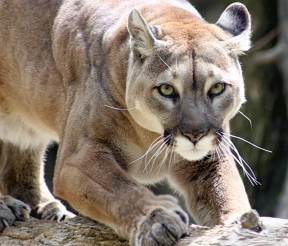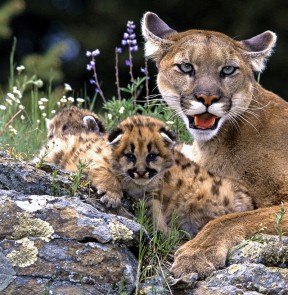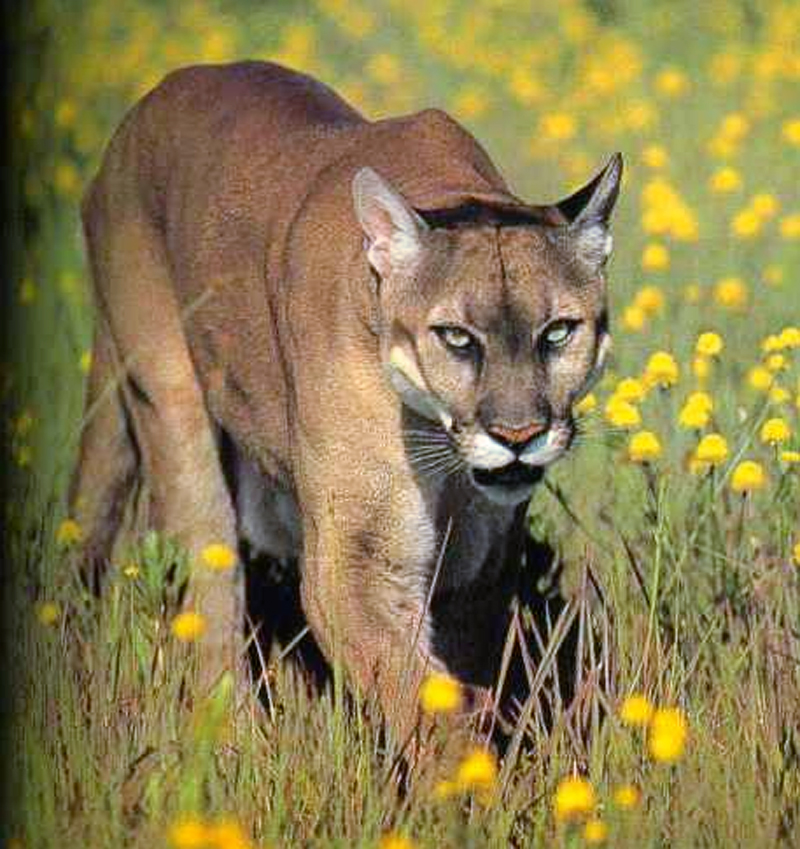 Puma, cougar or mountain lion? Even the name “panther” is sometimes used, but the only panther we have in United States is the Florida panther. It is a subspecies of the mountain lion that is found only in Florida. It is endangered, with only 50 large cats left.
Puma, cougar or mountain lion? Even the name “panther” is sometimes used, but the only panther we have in United States is the Florida panther. It is a subspecies of the mountain lion that is found only in Florida. It is endangered, with only 50 large cats left.
I was always surprised to hear the mountain lion called by other names, and wondered if it was another animal altogether – but no. It is still the same one.
Why so many names? It can be found in many parts of the country and gets “local” names that stick. The conquistadors from Spain called it leon (lion) and gato monte (cats of the mountains), so that name became mountain lion.
The Incas called it puma. “Cougar” comes from a South American Indian word, cuguacuarana. To shorten this, it became cuguar, and then the spelling changed to make it cougar. “Panther” seems to be a generic word for all large cats with a solid-color coat.
 After a while in California, I thought all of those were local terms, and that “mountain lion” was really the official name. Not so. I found out scientists use the name “puma,” and the Latin name is puma concolor.
After a while in California, I thought all of those were local terms, and that “mountain lion” was really the official name. Not so. I found out scientists use the name “puma,” and the Latin name is puma concolor.
What attracts us to the mountain lion?
By a strange set of circumstances and an incredible amount of luck, I was able to see a mountain lion in front of my house in the middle of the night through the front window. I was totally safe inside, but I can tell you the hair stood up on my head and I became cold with fear, but I was filled with admiration at the way the animal moved. You could feel the power in the supple and smooth walk; you could see the muscles flexing and the self-confidence of the great animal.
Suddenly it looked in my direction and swooshed its tail in the air, and I could tell it knew it was being watched.
It left, but I stood at the window filled with gratitude to have witnessed a wild king, inspiring respect and fear (even if it was attracted by a piece of rotten meat in my garbage can).
They are solitary cats and need to have a “home range” where they can hunt. The male range is larger and can overlap with the smaller ranges of a few females. They use trees as scratching posts, and they mark their territory with scrapes made of little piles of needles, leaves or dirt covered with urine or feces. That is a message for other mountain lions: Stay off, this is my place.
They are vocal. They can purr like a cat and they can hiss, yowl and scream – but they cannot roar. Faced with danger, they can make a shrill, piercing whistle which is also used by the female to call her cubs.
The average life span is 12 years, but some reports have been made of mountain lions between 18 and 20 years old, even in their natural habitat. They are great tree climbers (think of them as large cats), and they can jump high. They can make vertical jump of 4.6 feet up, and when they run, they can cover 23 feet in a single leap. They can swim, but they do not like to get wet, so it is an animal with few limitations and very powerful.
When they have a large prey they want to kill, they will start by stalking it from about 30 feet away, then they take two or three great running bounds to land on the victim’s back. They kill the prey by breaking the neck below the base of the skull with one bite. They will drag the body to a quiet place to eat in safety and will bury the rest to come back for a few days.
They kill deer, but also coyote, mice, marmots, hare, raccoons, birds, large insects such as grasshoppers, domestic animals and roaming livestock. They can even eat porcupines and do not seem to be bothered by the spines.
 They seem to be monogamous during the mating season. The female starts the courting and mating act. The gestation is about three months, but there is no regular time of the year for reproduction. They have an average of three kittens which are born wooly, spotted and with short tails. They will get teeth at one month old and are weaned at three months. They may stay with their mom until they are one year old and learn to hunt with her. An adult female will breed every other year.
They seem to be monogamous during the mating season. The female starts the courting and mating act. The gestation is about three months, but there is no regular time of the year for reproduction. They have an average of three kittens which are born wooly, spotted and with short tails. They will get teeth at one month old and are weaned at three months. They may stay with their mom until they are one year old and learn to hunt with her. An adult female will breed every other year.
Mountain lions should be feared and respected. If you see one on a trail, never try to approach it, and give it a way to escape. Stop and back away slowly. Do not run. Stand and face the animal. Pick up young children and put them on your shoulders. Speak firmly in a loud voice and make eye contact. Do not bend over to pick up stones, as you would look like a four-legged prey animal. Open your jacket and raise your arms to look big.
The idea is to convince the mountain lion that you are not prey, and that you could mean danger. Fight back if you are attacked; lions have been driven away by prey that fights back.
Do not hike or jog alone, especially at dusk or dawn when mountain lions are hunting.
Mountain lions do not want to confront humans. They do their best to avoid us, and meeting one is an unlikely event. Please keep it that way.
Evelyne Vandersande has been a docent at Placerita Canyon Nature Center for 27 years. She lives in Newhall.
A Mountain Lion by Any Other Name... | Commentary by Evelyne Vandersande

